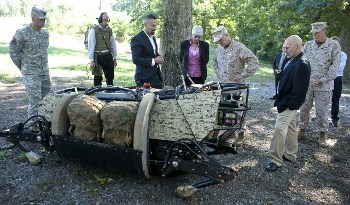 |
| September 25, 2012 | Volume 08 Issue 36 |
Designfax weekly eMagazine
Archives
Partners
Manufacturing Center
Product Spotlight
Modern Applications News
Metalworking Ideas For
Today's Job Shops
Tooling and Production
Strategies for large
metalworking plants
Engineer's Toolbox:
Marines test robotic pack mule in Virginia; BigDog grows up
By Courtney Dock (IMCOM)

The Defense Advanced Research Projects Agency (DARPA) demonstrated a robotic prototype of the Legged Squad Support System, or LS3, for Commandant of the Marine Corps Gen. James F. Amos and DARPA Director Arati Prabhakar on Joint Base Myer-Henderson Hall, Sept. 10. [Photo Credit: Rachel Larue, Pentagram]
The Marine Corps Warfighting Lab, in partnership with the Defense Advanced Research Projects Agency and Boston Dynamics, tested an autonomous robot on Joint Base Myer-Henderson Hall near Arlington, VA, Sept. 10.
The Legged Squad Support System, or LS3, demonstration was a performance test of the pack mule prototype for the Commandant of the Marine Corps, Gen. James Amos, and DARPA Director Arati Prabhakar.
While the LS3 may look like a cumbersome robotic creature from the future, its capabilities and agile functionality are designed with the dismounted warfighter in mind.
"Half of the Earth is inaccessible to wheeled and tracked vehicles," said Marc Raibert, principle investigator and lead for the LS3 group with Boston Dynamics. "People and animals, using their legs, can go almost anywhere. The idea behind this robot is to have a robot that can go anywhere on Earth."
Raibert explained that LS3 can go off-terrain in the woods, on rocks, in snow, and in water. "It can go where you can go with your legs, but where wheeled vehicles have a hard time," he said.
The main idea behind the LS3 is to use it as a robotic pack mule for hauling gear that has become burdensome for dismounted Marines and Soldiers on the battlefield. Today's servicemember can carry upward of 100 lb of gear, ammunition, and communications equipment on his body just to travel outside the confines of a forward operating base's perimeter or "wire." LS3's mission is to lighten that load.
Marine Corps Warfighting Lab, or MCWL, Head of the Logistics Combat Element Branch and Project Officer for LS3, Maj. James Richardson, said his office is responsible for experiments and technologies associated with lightening the load for the deployed servicemember.
"If you can imagine a squad of Marines, about 13 Marines on patrol, through the streets or an area with a lot of vegetation, a vehicle such as this could carry extra ammunition, water, chow, things of that nature. It would limit what the Marines are carrying," said Richardson.
The demonstration stopped traffic on busy McNair Road and showed more than 30 people how the LS3 is given directions from a leader and quickly adapts and follows the command much like a loyal canine would. It does not need to be driven, because the robot follows the leader using computer vision or travels to designated locations using sensing and GPS.
LS3 climbed muddy hills, crossed McNair Road, and even ran through the field to demonstrate its 7-mph speed over flat surfaces. LS3 proved that even after being placed in an overturned position, it could right itself and keep moving along its designated path.
The exhibition ended phase one of a three-phase series in LS3's development. Brig. Gen. Mark Wise, commanding general of MCWL, said the next 24 months will focus on refining the sensors and the interaction between the robot and the Marines LS3 operates with. The goal he said is to make LS3 more intuitive and taking the technology to a whole new level.
"So not only can it perceive the world around it better, it can interact with the Marines better," said Wise. "Right now it sees a bush and thinks it's an object it can't go through. In the next 24 months, the initiatives will look at other ways for the sensors already on board to see these obstacles and go through [them]."
The LS3's "head" is made up of three levels of sensors, all responsible for tracking its leader as well as objects as far out as 30 m and as close as directly in front of it as peripheral sensing. The "body" consists of its engine and cooling fans, as well as the main cargo areas.
Underneath the body are its four hydraulic-powered legs. It can carry up to 400 lb of gear, travel up to 20 miles, and operate for 24 hr; perfect for dismounted patrols down range.
Wise also added that in phase two, they will be looking for ways to make LS3 more intuitive for Marines to pick up the controls and operate the system. In this day of technology, MCWL, DARPA, and Boston Dynamics staff understand the importance of making the equipment they design for tomorrow as easy to operate as the everyday smartphones and video-game consoles that young servicemembers and future LS3 operators use now.
"We're using iPhone-type devices and applications through a militarized network that's very intuitive," said Wise. "It's a matter of 'Do I have an app that I can use, and can I pull that information forward?'"
"I tell you what, this generation of young men and women will be fascinated by this," said Amos. "They will not be one bit intimidated by this."
Both Amos and Prabhakar were visibly impressed with the capabilities and the future of LS3. Amos, when he led Marine Corps Combat Development Command in 2007, had a chance to view LS3's predecessor, BigDog.
"I'm very proud," said Amos. "For me, to see where it's gone just in the last four years and where it was with BigDog, which was fascinating, you had to have a leap of imagination to know that we would get there eventually. We're getting close. Very, very close," he said.
Published September 2012
Rate this article
View our terms of use and privacy policy
